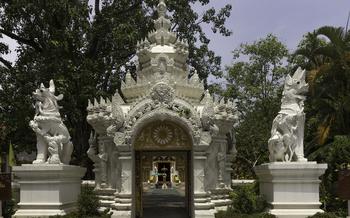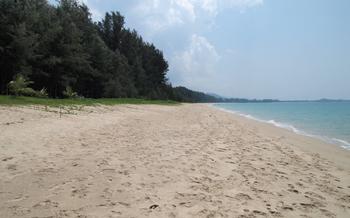
Ao Mangrove Forest
- Ao Mangrove Forest: A Hidden Gem in Ranong
- Exploring the Forest by Boat
- Spotting Wildlife in the Mangroves
- Learning About the Mangrove Ecosystem
- Kayaking Through the Mangroves
- Hiking Through the Mangrove Forest
- Camping in the Mangrove Forest
- Visiting the Mangrove Information Center
- Taking a Cooking Class
- Visiting the Local Markets
- Trying the Local Cuisine
- Visiting the Hot Springs
- Taking a Day Trip to Koh Chang
- Insider Tip: Best Time to Visit
Ao Mangrove Forest: A Hidden Gem in Ranong
Nestled along the picturesque coastline of Ranong, Thailand, lies a hidden gem waiting to be explored – the Ao Mangrove Forest. This enchanting natural wonder is a testament to the region's rich biodiversity and ecological significance. The forest's origins can be traced back centuries, as it has long served as a vital breeding ground and habitat for a diverse array of marine life. Its intricate network of waterways, teeming with life, has earned it the title of "Amazon of the East."
What truly sets the Ao Mangrove Forest apart from others is its unique ecosystem. The forest is home to a variety of mangrove species, each adapted to thrive in the harsh conditions of saltwater and fluctuating tides. These mangroves form a complex and interconnected web of life, providing shelter and sustenance to a myriad of creatures. The forest's labyrinthine channels and dense vegetation create a mesmerizing landscape, offering visitors a glimpse into the intricate workings of nature's delicate balance.
Exploring the Forest by Boat
There are several ways to explore the Ao Mangrove Forest by boat. You can rent a kayak or paddleboard and paddle through the mangroves at your own pace. This is a great option for those who want a more intimate and independent experience. You can also join a guided boat tour, which is a great way to learn more about the forest and its wildlife. Tours typically last for around two hours and include a visit to the mangrove information center.
No matter how you choose to explore the forest, be sure to bring plenty of water, sunscreen, and insect repellent. You should also wear comfortable shoes and clothing, as the mangroves can be muddy and slippery.
Here are some tips for choosing the best boat tour:
- Consider the size of the group. Some tours are small and intimate, while others can accommodate larger groups.
- Choose a tour that fits your budget. Prices vary depending on the length of the tour and the number of people in the group.
- Ask about the tour guide's experience and qualifications.
- Make sure the tour company is reputable and has a good safety record.
Spotting Wildlife in the Mangroves
The Ao Mangrove Forest is home to a diverse array of wildlife, including over 200 species of birds, 30 species of reptiles, and 10 species of mammals. Some of the most commonly spotted animals include monkeys, squirrels, monitor lizards, snakes, and a variety of bird species, such as kingfishers, hornbills, and egrets.
The best time of day for wildlife spotting is early morning or late afternoon, as these are the times when animals are most active. To observe wildlife respectfully, it is important to remain quiet and avoid making sudden movements. It is also important to keep a safe distance from animals and to avoid disturbing their natural behavior.
Here are some tips for spotting wildlife in the Ao Mangrove Forest:
- Use binoculars or a spotting scope to get a closer look at animals.
- Listen for the sounds of animals, such as bird calls or monkey chatter.
- Look for tracks, droppings, or other signs of animal activity.
- Be patient and persistent. It may take some time to spot animals, but the rewards can be great.
Learning About the Mangrove Ecosystem
The Ao Mangrove Forest is a treasure trove of biodiversity, home to a fascinating array of plant and animal species. Mangroves are unique trees that have adapted to thrive in the harsh conditions of the intertidal zone, where they are subjected to daily inundation by saltwater. Their intricate root systems help to stabilize the shoreline, prevent erosion, and provide a vital habitat for a multitude of marine life.
The forest is also an important breeding ground for many species of fish, shrimp, and crabs, which play a crucial role in the food chain. The mangroves provide shelter and food for these organisms, and their presence helps to maintain the health and productivity of the surrounding waters.
Unfortunately, mangrove forests around the world are under threat from a variety of human activities, including deforestation, pollution, and climate change. The Ao Mangrove Forest is no exception, and it is vital that we take steps to protect this precious ecosystem.
Several conservation efforts are underway in the Ao Mangrove Forest, including reforestation projects, community-based conservation initiatives, and educational programs. Visitors to the forest can contribute to these efforts by being respectful of the environment, following the designated trails, and avoiding littering. By working together, we can ensure that the Ao Mangrove Forest continues to thrive for generations to come.
Kayaking Through the Mangroves
Kayaking is another excellent way to explore the Ao Mangrove Forest. It offers a more intimate and hands-on experience, allowing you to paddle through the narrow channels and get up close to the mangrove trees and wildlife. Several kayak rental shops are located near the forest entrance, and you can choose from single or double kayaks.
If you're a beginner, consider taking a guided kayak tour. Experienced guides will lead you through the mangroves, pointing out interesting sights and wildlife along the way. They can also provide tips on paddling techniques and safety.
For a more adventurous experience, rent a kayak and explore the forest on your own. Just be sure to bring a map or GPS device, as it's easy to get lost in the mangroves. Also, be aware of the tides, as some areas may be inaccessible during low tide.
Whether you choose to go on a guided tour or explore on your own, kayaking through the Ao Mangrove Forest is a unique and unforgettable experience. It's a great way to see the forest from a different perspective and get a closer look at its incredible biodiversity.
Hiking Through the Mangrove Forest
Lace up your hiking boots and embark on an unforgettable journey through the heart of the Ao Mangrove Forest. A network of well-maintained trails winds its way through this verdant wilderness, inviting you to immerse yourself in the tranquil beauty of nature. Choose from leisurely strolls along the water's edge to challenging treks that lead you deep into the mangrove maze. As you wander beneath the towering canopies, marvel at the intricate root systems that intertwine with the earth, creating a mesmerizing tapestry of life. Keep your eyes peeled for the diverse flora and fauna that call this unique ecosystem home. Spot playful monkeys swinging through the trees, listen to the melodious calls of exotic birds, and catch a glimpse of shy reptiles basking in the sun. Remember to tread lightly and respect the delicate balance of this fragile environment. Leave nothing but footprints and take only memories with you.
Camping in the Mangrove Forest
For a truly immersive experience, you can camp overnight in the heart of the Ao Mangrove Forest. Designated campsites are available within the forest, offering a unique opportunity to connect with nature and witness the nocturnal activities of the forest's inhabitants.
The campsites are basic but provide essential facilities such as toilets, showers, and cooking areas. You'll need to bring your own tent and camping gear, but it's worth the effort for the chance to wake up to the sound of birdsong and the gentle lapping of the waves against the mangrove roots.
Camping in the mangroves is a great way to escape the hustle and bustle of everyday life and reconnect with the natural world. It's also a fantastic opportunity to learn more about the mangrove ecosystem and the importance of conservation.
Here are a few tips for camping in the Ao Mangrove Forest:
- Book your campsite in advance, especially during peak season.
- Bring plenty of insect repellent and sunscreen.
- Be aware of the tides and plan your activities accordingly.
- Respect the wildlife and the environment. Leave no trace and dispose of your waste properly.
- Enjoy the experience! Camping in the mangrove forest is a truly unique and unforgettable adventure.
Visiting the Mangrove Information Center
To delve deeper into the intricate world of the Ao Mangrove Forest, pay a visit to the Mangrove Information Center. Situated adjacent to the forest, this center serves as a treasure trove of knowledge about the significance and fragility of mangrove ecosystems. Step inside and embark on an educational journey, where interactive exhibits and informative displays shed light on the vital role mangroves play in protecting coastlines, providing habitat for diverse wildlife, and safeguarding water quality.
Taking a Cooking Class
Immerse yourself in the culinary delights of Ranong by taking a cooking class. Learn to prepare traditional Thai dishes using fresh, local ingredients under the guidance of experienced chefs. Classes are offered by local chefs and cooking schools, providing an authentic and hands-on experience. Whether you're a seasoned cook or a complete novice, there's a class to suit your skill level. Discover the secrets behind mouthwatering curries, fragrant stir-fries, and tantalizing desserts. Take your newfound culinary skills home and impress your friends and family with your newfound culinary prowess.
Tips for choosing a reputable cooking class:
- Do your research: Read reviews and recommendations online to find reputable cooking schools and classes.
- Consider your skill level: Choose a class that is appropriate for your cooking experience and skill level.
- Look for authenticity: Opt for classes that use traditional Thai recipes and ingredients to ensure an authentic culinary experience.
- Check the class size: Smaller class sizes allow for more personalized attention from the chef and a more intimate learning environment.
- Inquire about dietary restrictions: If you have any dietary restrictions, make sure to inform the cooking school in advance so they can accommodate your needs.
Visiting the Local Markets
The local markets in Ranong are a great place to experience the local culture and find fresh, delicious food. The main market is located in the town center and is open every day from early morning until late evening. Here, you can find a wide variety of fresh seafood, fruits, and vegetables, as well as traditional Thai snacks and sweets.
If you're looking for a more unique experience, head to the floating market, which is located on the Ranong River. Here, you can buy fresh produce and souvenirs from vendors who sell their goods from boats.
When shopping at the local markets, be sure to bargain for the best prices. Most vendors are willing to negotiate, and you can often get a good deal if you're willing to haggle.
Here are some tips for visiting the local markets in Ranong:
- Arrive early in the morning to get the best selection of fresh produce.
- Bring cash, as most vendors do not accept credit cards.
- Be prepared to bargain for the best prices.
- Dress comfortably, as the markets can be hot and crowded.
- Try some of the local snacks and sweets, such as khanom krok (coconut pancakes) and roti sai mai (sweet sticky rice wrapped in banana leaves).
Trying the Local Cuisine
Ranong's culinary scene is a blend of Thai, Burmese, and Chinese influences, resulting in a unique and flavorful cuisine. Must-try dishes include:
-
Ranong Crab Curry: This is the signature dish of Ranong, made with fresh crabmeat, coconut milk, and aromatic spices.
-
Gaeng Som Pla Kapong Noon: A spicy and sour soup made with snakehead fish, bamboo shoots, and wild betel leaves.
-
Khao Soi: A noodle dish with chicken or beef in a creamy coconut curry sauce, topped with crispy noodles.
-
Khanom Chin: Fermented rice noodles served with a variety of dipping sauces, including a spicy chili sauce and a sweet peanut sauce.
-
Roti with Satay: A crispy flatbread served with skewers of grilled chicken or beef, and a peanut dipping sauce.
The best places to sample Ranong's cuisine are the local markets and street food stalls. Here are some tips for eating safely and avoiding stomach problems:
-
Choose reputable restaurants and food stalls: Look for places that are clean and busy, as this is a good indication of fresh food.
-
Avoid raw or undercooked food: This includes seafood, meat, and vegetables.
-
Be cautious with street food: While street food is generally safe in Thailand, it is important to be careful about what you eat. Avoid food that has been sitting out for a long time, and make sure it is cooked thoroughly.
-
Drink bottled water: Tap water in Ranong is not safe to drink, so it is important to drink bottled water instead.
Visiting the Hot Springs
Ranong is renowned for its natural hot springs, which are believed to possess therapeutic properties. They are located in a scenic area surrounded by lush greenery, offering a tranquil retreat for visitors seeking relaxation and rejuvenation. The hot springs are easily accessible and open to the public for a small entrance fee.
The water in the hot springs is naturally heated by geothermal activity and is rich in minerals, including sulfur, which gives it a distinct odor. Visitors can soak in the hot springs, which are said to alleviate various ailments such as muscle pain, joint stiffness, and skin conditions. The hot springs are also popular among locals who believe that bathing in the water brings good luck and fortune.
When visiting the hot springs, it is important to be mindful of the following tips:
- Arrive early in the morning or late in the afternoon to avoid the crowds.
- Bring a swimsuit, towel, and sandals.
- Stay hydrated by drinking plenty of water before and after soaking in the hot springs.
- Do not soak for more than 20 minutes at a time to prevent overheating.
- Avoid swimming or diving in the hot springs, as the water can be very hot and deep.
- Be respectful of other visitors and maintain a quiet and peaceful environment.
Taking a Day Trip to Koh Chang
Koh Chang, the second-largest island in Thailand, lies just off the coast of Ranong and makes for a fantastic day trip. With its pristine beaches, lush jungles, and vibrant coral reefs, Koh Chang offers a diverse range of activities for visitors.
To get to Koh Chang, you can take a ferry from Ranong Pier, which takes about an hour. Once on the island, you can rent a motorbike or bicycle to explore its many attractions.
For those who love the beach, Koh Chang has several stunning options to choose from. White Sand Beach is the most popular, with its long stretch of white sand and crystal-clear waters. Lonely Beach is a more secluded option, perfect for those seeking peace and tranquility.
If you're interested in exploring the island's interior, there are several hiking trails that wind through the jungle. These trails offer stunning views of the island's lush vegetation and wildlife.
For those who love snorkeling or diving, Koh Chang has some of the best coral reefs in Thailand. There are several dive shops on the island where you can rent equipment and book guided tours.
Koh Chang is a great place to visit for a day trip from Ranong. With its beautiful beaches, lush jungles, and vibrant coral reefs, there's something for everyone on this stunning island.
Insider Tip: Best Time to Visit
The best time to visit the Ao Mangrove Forest is during the dry season, which runs from November to April. During this time, the weather is generally sunny and dry, with low humidity and pleasant temperatures. This makes it ideal for exploring the forest by boat, on foot, or by kayak.
The rainy season, which runs from May to October, can be a good time to visit if you're looking for a more secluded experience. However, be prepared for heavy rainfall and muddy conditions, which can make it difficult to navigate the forest.
Avoid visiting during the hottest months of the year, March and April, when temperatures can reach up to 40 degrees Celsius. This can make it uncomfortable to explore the forest, especially during the midday hours.
Also, check the tide schedule before planning your visit. The best time to explore the forest by boat is during high tide, when the water levels are higher and you can get closer to the mangroves.




